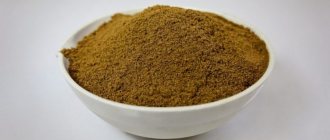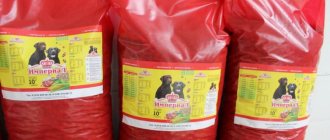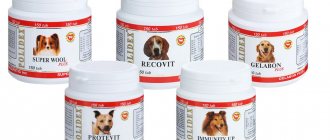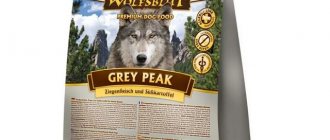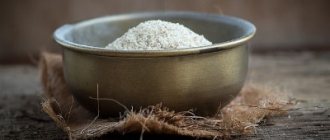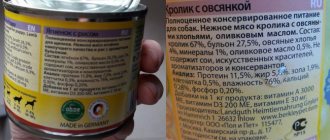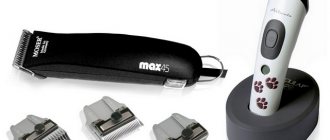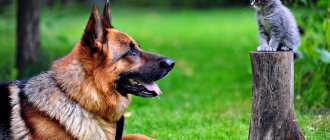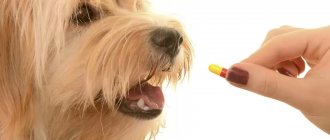One of the common food additives that dog breeders include in the diet of their shaggy pets is meat and bone meal. Wanting to supply the dog's body with valuable microelements, their owners sometimes show excessive zeal. With the best of intentions, someone literally stuffs their tailed friend with various vitamins and supplements. But, unfortunately, the effect is often just the opposite.
What is this “magic” supplement? What is it made from? Is it really necessary for the four-legged body? How should the supplement be introduced into the diet so as not to harm the pet? Let's figure this out together.
What is meat and bone meal and how to give it to dogs
Meat and bone meal is a dietary supplement; it has the form of a crumbly powder and is added to pet food. The product can be of different colors - from milky to red-brown, and the grind size also varies.
Flour is sold in pet stores and pharmacies in plastic containers and soft packages weighing 0.5 - 1 kg.
It can be given to both adult dogs and puppies. Important! A quality product should smell like roasted meat, and the consistency should not have lumps.
Benefits and harms
In addition to the high protein content, the benefits of flour are as follows:
- Availability of vitamins A, B, D, E.
- The presence of substances such as sodium, calcium, phosphorus and iron, manganese, copper, remnants of the hormones serotonin and thyroxine. All elements are easily digestible.
- Help in the treatment of rickets, dystrophy and vitamin deficiency.
- Prevention of nervous system disorders.
- Possibility of correction of developmental delays.
- Formation and strengthening of the musculoskeletal system, improvement of muscle tone.
- Active growth of strong teeth in puppies.
- Stimulation of one's own immunity.
- Ensuring weight gain and normalizing metabolic processes.
- Improved health after childbirth or illness.
What negative consequences can occur when consuming meat and bone supplements:
- If you feed your dog flour uncontrollably, protein and protein metabolism may be disrupted, which leads to the development of gout - the deposition of salts in the joints, or amyloidosis, that is, the accumulation of protein in the soft tissues of the body.
- The supplement should not be used for diseases of the stomach or intestines (gastritis or ulcers).
- Meat and bone meal is a fatty product, so in large quantities it causes liver and pancreas diseases.
- The product can potentially cause allergies due to individual intolerance to the components. Then the dog will experience itching, hair will fall out, and constant diarrhea will begin.
Good to know! Animal bone meal contains 50% protein and 20% fat, so it is very nutritious and high in calories.
Flour is rich in minerals, but cannot replace the entire complex of vitamins
Veterinarians recommend giving minced meat in the form of balls boiled in boiling water or frozen in advance.
... this way you reduce the risk of your pet becoming infected with parasites. The loss of the protein component in this case is minimal and amounts to approximately 6% of the raw product.
Great side dishes for minced meat include cereal porridges, vegetable soups and stewed vegetables, nettles poached in boiling water, sliced apples and pears, cucumbers, grated carrots, bran, pumpkin, and beets. For dogs that are not prone to allergies, you can even give orange mixed with minced meat in small quantities, which will act as a natural source of vitamin C.
IMPORTANT: carefully study the product label; do not purchase minced bones in markets and stores where there is no guarantee that the bone component of the minced meat will be ground into flour. Pay attention to the percentage of fat content in the product; its excess can provoke a number of diseases of the liver and biliary tract.
Another feature of minced bone is that if it contains under-ground bone particles, a bone plug may form in the dog’s stomach. To prevent its formation, you should include in the diet only minced meat where the bones have previously been ground into bone meal, add sunflower and flaxseed oils to the diet on the day of feeding minced meat, and also do not abuse the product itself. It is optimal to include minced bones in the diet for dogs once a week, as an alternative to meat and fish components.
Composition and features of the product
Meat and bone meal for dogs is made from rejected farm animals. Carcasses are first sterilized to eliminate harmful bacteria and parasites by applying high temperatures to soften the bone mass. Then they are dried and crushed using a special sieve.
The resulting flour is treated with an oxidizing agent before packaging. Meat of various qualities can be used for flour, so it can be divided into three categories:
- Products from large animals that lived in environmentally unfavorable areas, areas with high radiation. They could also die as a result of the epidemic. Class 1 additives may contain traces of hormones or drugs administered to livestock during life.
- From carcasses selected by municipal organizations.
- From farm animals raised specifically for human consumption. Class 3 flour means that it has successfully passed the veterinary test. services.
Interesting! Flour is not only meat, there is also a fish version.
Why do the body need chondroitin and glucosamine?
Glucosamine is part of chondroitin, synovium, and is a building material for cartilage, as well as tendons, ligaments and muscles, providing strength and resistance to stretching.
Chondroitin is produced by cartilage tissue and is also a component of intra-articular fluid. Due to the fact that it retains water and stimulates the production of hyaluronic acid, the strength and elasticity of the joints is maintained.
Thus, chondroitin with glucosamine for joints is necessary for the normal functioning of the osteochondral system.
With a deficiency of glucosamine and chondroitin, the quality of the synovial fluid changes, which leads to a change in the function of the joint - friction occurs between the bones and subsequent wear.
Glucosamine and chondroitin are synthesized in small quantities in the body independently, but with age, as well as during heavy physical activity, injury and inflammation, their quantity decreases and the deficiency must be replenished from the outside. If treatment is started at the wrong time, irreversible consequences begin in the joints, which can lead to osteoarthritis.
Use for puppies and adult dogs
Adult dogs need to consume 5 grams per 10 kg of weight per day. Flour is not given in its original form, but mixed with feed or other dishes, for example, cottage cheese or kefir, simply stirred in water until it becomes a paste. Large animals such as shepherd dogs, huskies, divers, and pit bulls are usually regularly offered pork and beef bones, so their dose of dietary supplement should be less.
The growing body of puppies especially needs additional minerals and vitamins. Since they cannot yet chew real cartilage and bones, a finely ground flour mixture will come in handy.
In accordance with the instructions, the daily norm for babies from 2 months, as well as for pregnant females is about 10 grams, calculated per 10 kg of the animal’s body. This dosage is also suitable for small dogs (Yorks, Pekingese, pugs, toy terriers). Small pet puppies should divide the portion into several parts and feed them over several meals.
Important! Flour for children and elderly animals with poor health should only be of the highest category 3. The class is indicated on the product packaging.
The product is strictly dosed and does not exceed 100 grams per day for any dog
Meat and bone meal
Meat and bone meal is a source of high-value proteins and minerals for dogs. It is prepared from the by-products of farm animals, discarded carcasses not suitable for human consumption, as well as from carcasses that have died from non-contagious animal diseases. Meat and bone meal contains up to 50 percent proteins and up to 25 percent minerals. Meat and bone meal can partially replace meat if you feed it to adult dogs no more than 100g per day.
Dogs are gradually accustomed to this food by feeding it in a mixture with other foods and no more than twice a week. It is most beneficial to add this food little by little to the soup, especially for young animals, puppies and lactating bitches. At the same time, meat and bone meal increases the content of mineral elements, especially phosphorus, in the dog’s body. Milk and dairy products in dog diets can replace part of the meat and account for 3-5 percent of the total calorie intake.
Milk contains all the essential nutrients. Cow, goat, sheep, mare, camel, buffalo and yak milk are used in feeding dogs. Milk is especially valuable for puppies, chipped and lactating bitches, as well as sick and malnourished dogs. Milk is fed raw. If there is a lack of milk in lactating bitches, newborn puppies begin to be fed cow's milk from 3-4 days of age, in other cases - from 15-20 days, starting with a small amount (50g), and by 3 months the norm is increased to 0.4- 0.5 l per day.
Puppies are fed milk until they are 6 months old. Puppy and lactating bitches can be fed milk up to 1 liter per day. Along with raw milk, you can also feed fermented milk, which acquires antibiotic properties. Skim milk (skim milk) is also given to dogs in raw and fermented form. For adult dogs, this food is most often given in pasteurized or boiled form in quantities of up to 1 liter or more per day.
Skim milk is added to plant foods, which dogs eat more readily. Cottage cheese is a highly nutritious and easily digestible food. It is fed to both young animals and adult dogs. Puppies begin to be given cottage cheese from the suckling period, are taught gradually from a small amount, and by the age of 6 months the rate of cottage cheese is increased to 50-100 g per day.
Cottage cheese is fed to adult dogs instead of meat, and also as a dietary food for sick dogs up to 0.5 kg per day. Dogs whose diet does not contain meat are given 0.6-1 kg of cottage cheese per day. Salted cottage cheese is soaked in water for 15-20 minutes before feeding. It must be remembered that a large amount of cottage cheese can cause constipation.
Adding flour to your pet's diet
The meat and bone supplement is used in strictly prescribed dosages for puppies, small and large dogs. The supplement will be beneficial if you use it correctly.
How and how much you can give
For small individuals, as already mentioned, the portion of flour is reduced: more than 6-7% of the volume of food per day is allowed; For medium-sized pets, add a maximum of 14-15% flour to the diet, for large pets - up to 20%. The dietary supplement is added to the food immediately before feeding the dog. If food needs to be reheated first, this is done without flour powder.
The food mixture is introduced fractionally and gradually over 1-2 weeks until the pet gets used to it. Otherwise, the new ingredient will cause digestive problems.
Despite the obvious benefits of such products, vitamin supplements cannot be replaced with them. Also, the nutritional value of meat and bone meal is not considered a reason to remove natural meat food from a dog’s diet.
Attention! Premium dry food already contains the necessary complex of substances. Therefore, it is not recommended to add meat and bone meal, as it can be harmful due to the oversaturation of the body with minerals.
General information
Meat and bone meal is a product obtained from the remains of animal products. It is valued for its excellent nutritional properties, as well as for its content of beneficial microelements.
According to the standard, the content of substances in it should be as follows:
- 45–50% protein
- 30–35% ash
- 8–15% fat.
- 4–8% water
The production and processing of bone meal takes place in special workshops, in compliance with all sanitary and hygienic standards. Also during the production process, care is taken to ensure that no larvae get into the flour, and treatment against microorganisms is also carried out. This is an important point, otherwise this product can cause great harm to dogs.
Self-production
This supplement can be made at home:
- Prepare the ingredients - poultry meat and bones, you can add fish.
- Cut into pieces and place in a large saucepan, fill completely with clean water and place on the stove.
- Simmer over low heat until the bone mass softens.
- Cool the finished dish.
- Grind the product into smaller parts using a blender or chopper. To obtain the powder, you need to use a mortar.
- The flour needs to be dried.
- Remove large and sharp pieces from it, if they remain after all the treatments.
Another way to create a dietary supplement is to use large bones from pork or beef. It is more convenient to cook them over an open fire - you need to make a fire. Wait for the first level of firewood to finish burning, then spread the raw materials onto the coals. Another layer of wood is placed on top and the fire is lit.
You need to carefully observe, and when the bones soften, cover them with a cloth. The final stage is grinding using heavy objects, for example, a rolling pin, a hammer. To get the consistency of flour, you should take a grain processing machine.
The additive is easy to make yourself from leftover meat and bones
Large fish
Before cooking, large fish should be first cleaned of scales and entrails; small fish should be cooked until it is boiled and the bones become soft. Salted fish should be thoroughly soaked before cooking. Although fish serves as a source of protein nutrition, it cannot completely replace meat products.
Therefore, you cannot feed dogs only fish: it must be alternated with meat. For dogs, it is better to use sea fish, which can be fed both raw and boiled. As part of animal products, fish feed should account for no more than 3-5 percent of the total calorie intake. Dogs are also fed fishmeal.
The most suitable for feed purposes is fishmeal, which contains no more than 10 percent fat and 22 percent minerals. Adult dogs are given no more than 50 g of fishmeal, puppies - no more than 20 g per day. Dogs eat fish oil, which is very rich in vitamins, quite willingly. Most often, fish oil is fed to puppies to prevent the occurrence of rickets.
During the suckling period, puppies are given a few drops of fish oil per day, at the age of 2 months - a teaspoon, after which the dose is adjusted to a tablespoon. Fish oil can be used as a dietary supplement.
If a dog develops diarrhea, fish oil should be immediately removed from the diet. Fish oil is fed to puppy and lactating bitches in the amount of 30-50 g, to male dogs during the mating period - 20-30 g per day. It is recommended to store fish oil in a dark place, since in the light vitamin D turns into a toxic substance - toxysterol. From animal products, dogs are also given eggs and animal fats. Raw chicken eggs are given as additional nutrition to puppies, nursing bitches, sick dogs, male dogs during the mating period and instead of meat.
Product storage
As with other types of food, certain storage standards must be observed for dog dietary supplements. In accordance with the mandatory requirements you need:
- Check the expiration date of flour: it usually lasts for a year.
- The temperature should be +20 - +28 degrees.
- Store only in a ventilated area with low humidity.
- Avoid direct exposure of the product to the sun.
- Take care of the tightness of the packaging.
- Isolate from proximity to food that has a strong odor, otherwise the product will quickly absorb impurities.
Important! Improper storage of flour leads to spoilage and acidification, and with further use it can cause side effects - painful symptoms of varying intensity.
Veterinarians advise feeding your pet with various supplements. Many of them are available at pet supply stores. However, it is not necessary to spend a lot of money on them - it will be much cheaper and healthier to make complementary foods yourself, using proven, natural ingredients.
From dairy waste
Whey and buttermilk are also fed to dogs from dairy waste. Whey contains a large amount of milk sugar. Most often, milk waste is used in the preparation of porridge. In their natural form, these products can be used as laxatives. Buttermilk, due to its high lecithin content, serves as a therapeutic agent for liver diseases, anemia, etc. Technical casein is fed to dogs whose diet is dominated by plant foods. It contains up to 80% proteins and can serve as a meat substitute.
Casein must be boiled before feeding. Keep in mind that dairy products should not be stored in galvanized containers. The combination of lactic acid with zinc causes catarrh of the mucous membranes of the gastrointestinal tract, as well as stomach and duodenal ulcers in dogs. Fish and fish waste are sources of complete proteins.
In terms of nutritional value, fish products are not inferior to meat and meat by-products. In addition to proteins, they contain highly digestible fats, vitamins A and D and many macro and microelements. The composition of fish feed varies depending on the type of fish, its age, and the fishing season. Fish waste has a lower protein content than whole fish. To feed dogs, they usually use small, unsalted fish, which are of little palatability for human consumption.
Fish waste must be of good quality. Otherwise, they can cause poisoning and illness in dogs. Many types of fish contain the enzyme thiaminase, which, when fed raw, causes B-vitaminosis in dogs. The largest amount of this enzyme is found in fish entrails and heads.
Therefore, you need to feed raw fish intermittently. On days when the dog's diet does not contain fish, they need to be given increased doses of thiamine. Some types of fish, such as whiting, hake, pollock, cod, haddock, etc. contain trimethylamine oxide, which binds iron in the diet and converts it into an indigestible form.
As a result, dogs develop a severe form of anemia and their coat color changes. Boiling fish eliminates its negative effects. When feeding fish raw, it is necessary to use glandular preparations. Dogs are gradually accustomed to feeding fish in large quantities.
"Hercules"
Hercules cereal has a very good effect on the dog’s body. Semolina is highly digestible. Corn grits are characterized by relatively low digestibility. Its distinctive property is the ability to inhibit the processes of fermentation and putrefaction in the intestines. Corn grits contain relatively a lot of iron, copper and nickel, which has a beneficial effect on hematopoiesis. Millet contains a lot of nicotinic acid, copper, manganese and zinc.
When millet is stored for a long time, the fats it contains quickly oxidize, and the grain acquires a bitter taste. Buckwheat is rich in lecithin, which determines its use for liver disease. Pearl barley and barley grains have a significant fiber content. It is better to cook them in a mixture with millet and oatmeal.
The digestibility of nutrients from pearl barley and barley is relatively low, but they contain a significant amount of iron and folic acid, which determines their use to stimulate hematopoiesis. Pearl barley is included in the diet of dogs for obesity and constipation. Rice for dogs is a dietary food.
Like oatmeal, when boiled it forms a significant amount of mucous decoction, which has a beneficial effect on the gastrointestinal tract. The daily grain intake for adult dogs is on average 200-250g, for puppies during the suckling period - 30-50g, from 1 to 3 months - 80-100g, from 4 to 6 months - 120-150g. Flour for feeding dogs is used in the form of boiled mash. In terms of digestibility of nutrients, mash made from flour is inferior to cereal porridges and therefore is used quite rarely. Cereals and flour used in feeding dogs must be fresh. They should not have a musty smell, mold and should not have a bitter taste.
Vegetables and root vegetables for dogs are an important source of vitamins, minerals, highly soluble sugar, starch, organic acids, pectin and fiber. These foods increase the secretion of the digestive glands and enhance their enzymatic activity, which improves digestion processes and increases the absorption of nutrients.
These properties make vegetables and root vegetables an essential part of a dog's diet. In the diet of adult dogs, the content of vegetables and root vegetables should be about 8-10 percent of the daily calorie intake.
Dogs are given potatoes, carrots, cabbage (fresh and pickled), beets, lettuce, sorrel, spinach, carrot and beet tops, etc. Potatoes have the highest nutritional value among root vegetables. However, it is difficult to digest. There is evidence that it reduces the absorption of B vitamins. Therefore, it should be used rarely in feeding dogs, only in the absence of other vegetables. Potatoes are fed only boiled.
Be sure to wash it before cooking. Remove spoiled, rotten, and moldy tubers. Boiled potatoes turn sour quickly, so they are fed freshly boiled.
